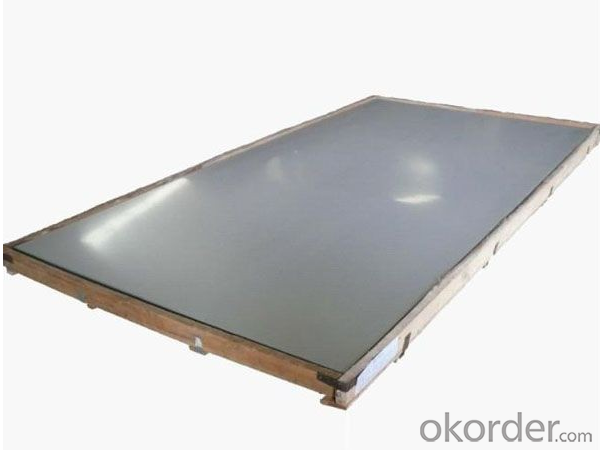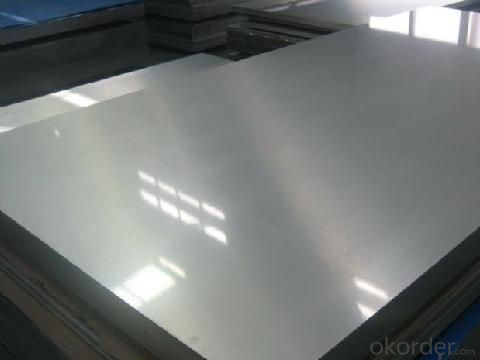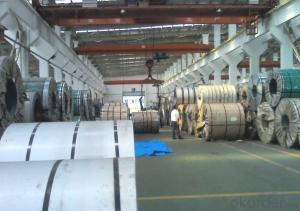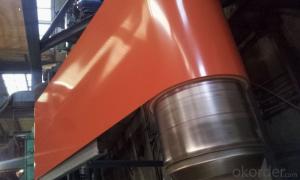Stainless Steel Sheet SS 201/304/316/304L/316L/309S/310S/430
- Loading Port:
- China main port
- Payment Terms:
- TT or LC
- Min Order Qty:
- 50 m.t.
- Supply Capability:
- 1000 m.t./month
OKorder Service Pledge
OKorder Financial Service
You Might Also Like
1.Structure of Stainless Steel Sheet Description
The surface brightness and flatness of no2B is better than no2D. then through a special
surface treatment to improve its mechanical properties,No2B could nearly satisfy comprehensive uses.
2.Main Features of the Stainless Steel Sheet
• Hardness (HB): ≤ 187
• Tensile strength (Mpa): ≥ 520
• Yield strength (Mpa): ≥ 205
• Elongation %: ≥ 40
• Reduction in area %: ≥ 50
• Recommended heat Treatment: 1030 ' C -1180 ' C
3. Stainless Steel Sheet Images


4. Stainless Steel Sheet Specification
| Grade: | 200series.300series. | Standard: | JIS,AISI,ASTM | Length: | as request |
| Thickness: | 0.3-3mm | Width: | 30-2000mm | Place of Origin: | Shanxi China (Mainland) |
| Brand Name: | CNBM | Model Number: | ss201/304/316/304L/316L/309S/310S/430 | Type: | Plate |
| Application: | hardware, foodstuff, manufacture, medic | Certification: | SGS | Item: | ss202/304/316/309s/310/410/420 stainless steel sheet |
| Packaging: | Export standard package or as your requirement | Delivery: | In 15 days | Stock: | Available |
5.FAQ of Stainless Steel Sheet
①Who are you?
We are the manufacturer! We produce stainless steel products
with high quality & very competitive price!Please feel free to
contact us for more information!
②How long can we receive the product after purchase?
In the purchase of product within three working days, We will arrange the factory delivery as soon as possible. The pecific time of receiving is related to the state and position of customers.Commonly 7 to 10 working days can be served.
③How about your company?
A world class manufacturer & supplier of castings forging in Stainless Steel Sheet,is one of the large-scale professional investment casting production bases in China,consisting of both casting foundry forging and machining factory. Annually more than 8000 tons Precision casting and forging parts are exported to markets in Europe,America and Japan. OEM casting and forging service available according to customer’s requirements.
- Q:How are steel strips inspected for quality and defects?
- Quality and defect inspections of steel strips entail a comprehensive procedure utilizing various techniques and tools. Visual inspection, a commonly employed method, involves a meticulous examination by trained personnel to detect visible imperfections such as surface flaws, scratches, cracks, or irregularities in thickness or width. This ensures that the strips meet the desired visual criteria and specifications. In addition to visual inspection, non-destructive testing (NDT) techniques are frequently utilized to identify internal defects that may be imperceptible to the naked eye. NDT methods encompass magnetic particle inspection, ultrasonic testing, eddy current testing, and dye penetrant testing. These techniques enable inspectors to pinpoint potential flaws like internal cracks, voids, or inclusions that could compromise the quality of the steel strips. Furthermore, precision measurement tools are employed to ensure the dimensional accuracy of the steel strips. This may involve the use of calipers, micrometers, or laser measurement devices to verify the strip's thickness, width, and length. Any deviation from the specified dimensions is deemed a quality concern and necessitates further investigation. Moreover, laboratory testing is commonly conducted to evaluate the mechanical properties of the steel strips. Tensile testing is performed to determine the strip's strength, elongation, and yield point. Hardness testing is also carried out to assess the strip's resistance to indentation or deformation. These tests ensure that the steel strips possess the necessary mechanical properties for their intended applications. In conclusion, the inspection of steel strips for quality and defects is a multi-step process that encompasses visual examination, non-destructive testing, dimensional measurement, and laboratory analysis. By employing these techniques, manufacturers can guarantee that their steel strips adhere to the required quality standards and deliver reliable and defect-free products to their customers.
- Q:How are steel strips used in the manufacturing of medical devices?
- Due to their unique properties such as strength, durability, and corrosion resistance, steel strips have found wide usage in the manufacturing of medical devices. These strips are typically composed of stainless steel, an alloy renowned for its exceptional mechanical and chemical characteristics. In the medical device industry, steel strips serve a multitude of purposes. One common application is their use in producing surgical instruments like scalpels, forceps, and scissors. These instruments require a sturdy and sharp edge, which can be achieved by shaping and sharpening the steel strips. The stainless steel composition ensures that the instruments remain resistant to corrosion, reducing the risk of contamination during medical procedures. Moreover, steel strips are employed in the production of medical implants such as pacemakers, joint replacements, and spinal fixation devices. These implants necessitate robustness and biocompatibility to ensure long-term functionality and patient safety. Steel strips provide the requisite strength for these implants, enabling them to withstand the forces and stresses they may encounter within the human body. Additionally, steel strips find use in fabricating medical equipment, including imaging devices like X-ray machines and MRI scanners. These devices demand a stable and rigid structure to maintain accuracy and precision. Steel strips offer the necessary structural integrity, facilitating the precise alignment of components and ensuring optimal performance of the equipment. Furthermore, steel strips are utilized in the manufacturing of medical tubing, catheters, and stents. These devices often require a combination of flexibility and strength to navigate through the intricate pathways of the body. Steel strips can be shaped and formed into thin tubes or wires, enabling the production of flexible yet sturdy medical devices. In conclusion, steel strips play a vital role in the manufacturing of medical devices. Their strength, durability, and corrosion resistance make them an ideal material for various applications in the medical industry. Whether it is for surgical instruments, implants, medical equipment, or tubing, steel strips contribute to the production of high-quality and reliable medical devices that enhance patient care and improve medical outcomes.
- Q:How are steel strips tested for dimensional accuracy?
- Various methods and equipment are used to test the dimensional accuracy of steel strips. One common approach involves the use of precision measuring instruments like calipers or micrometers, which accurately measure the length, width, and thickness of the strips. This ensures that the dimensions of the steel strips meet the required specifications. Another method involves optical measurement systems, which employ cameras and laser sensors to capture the dimensions of the steel strips. These systems can quickly and accurately measure the dimensions of multiple strips simultaneously, making them ideal for high-volume production lines. In addition to direct measurements, non-contact techniques such as laser scanning or optical profilometry can be used to test the dimensional accuracy of steel strips. These techniques create a 3D representation of the strip's surface, enabling detailed analysis of its dimensions and shape. Automated inspection systems can also be employed to ensure the dimensional accuracy of steel strips. These systems utilize sensors and computer algorithms to detect any deviations from the specified dimensions and automatically reject faulty strips. This not only improves quality control but also enhances the efficiency of the production process. Overall, the testing process for dimensional accuracy involves a combination of manual measurements, optical measurement systems, non-contact techniques, and automated inspection systems. These methods collectively guarantee that the steel strips meet the required dimensional specifications, ensuring their quality and suitability for various applications.
- Q:Is there any difference between galvanized steel strip and galvanized sheet?
- Galvanized strip is the same as galvanized sheet, but it has a narrow width and a roll in a pan. Galvanized sheet is also used to flatten the material. The width is 1000~1800., and the strip is almost 1000
- Q:How are steel strips used in the production of kitchen utensils?
- Kitchen utensils utilize steel strips in various ways during production. Firstly, these strips serve as the primary material for the utensils. Steel is renowned for its robustness and endurance, making it an exceptional choice for utensils that must endure frequent usage and exposure to heat and moisture. The strips undergo cutting, shaping, and forming processes to create diverse utensil shapes, such as spoons, forks, and spatulas. Furthermore, steel strips find application in manufacturing the handles of kitchen utensils. These strips are bent, molded, and affixed to the main body of the utensil to provide users with a comfortable and sturdy grip. To enhance grip and prevent slipping, the steel handles are often coated with materials like rubber or plastic. Additionally, steel strips are utilized for producing cutting utensils like knives. These strips are sharpened to form the blade, which is then attached to a handle. The steel used for knife blades undergoes hardening and tempering processes to ensure sharpness and longevity. To sum up, steel strips play a vital role in the production of kitchen utensils. They provide the necessary strength and durability for utensils to withstand daily use and can be shaped into various designs. Whether used as the base material, for handles, or for blades, steel strips are an indispensable component in the manufacturing process of kitchen utensils.
- Q:How are steel strips inspected for defects?
- Steel strips are inspected for defects through various methods such as visual inspection, ultrasonic testing, magnetic particle inspection, and eddy current testing. These techniques enable the detection of surface imperfections, cracks, and other structural flaws in the steel strips, ensuring their quality and compliance with industry standards.
- Q:How are steel strips used in the defense sector?
- Steel strips are used in the defense sector for various applications such as manufacturing armored vehicles, aircraft carriers, submarines, and military tanks. These strips are utilized to reinforce structures, provide protective shielding, and enhance the overall strength and durability of defense equipment.
- Q:How do steel strips contribute to reducing maintenance costs in various applications?
- Steel strips contribute to reducing maintenance costs in various applications by providing a durable and corrosion-resistant material. These strips are highly resistant to wear and tear, making them ideal for use in applications where frequent maintenance is required. Additionally, their strength and stability help to prolong the lifespan of the components they are used in, reducing the need for repairs or replacements. Overall, steel strips offer cost savings by minimizing maintenance requirements and ensuring long-term reliability in various industries.
- Q:How are steel strips processed for fire resistance?
- Steel strips can be processed for fire resistance using several methods. One common method is to apply a fire-resistant coating to the surface of the steel strip. This coating is designed to provide a protective barrier that can withstand high temperatures and prevent the steel from reaching its critical temperature, which is the temperature at which it loses its structural integrity. The fire-resistant coating can be applied through various techniques such as spray coating, dip coating, or electrostatic deposition. Another method of processing steel strips for fire resistance is through the application of intumescent coatings. These coatings are designed to expand when exposed to high temperatures, forming a thick and insulating layer that acts as a shield against heat transfer. Intumescent coatings can be applied as a paint or a thin film on the surface of the steel strip. Additionally, steel strips can also be processed for fire resistance through the use of fire-resistant insulation materials. These materials are applied to the steel strip to provide additional insulation and protection against heat. Insulation materials can include mineral wool, ceramic fiber, or vermiculite boards, which are known for their high resistance to fire. It is important to note that the specific process of fire resistance for steel strips may vary depending on the intended application and the required level of fire protection. Therefore, it is essential to consult with experts in the field of fire protection to determine the most suitable method of processing steel strips for fire resistance in a particular scenario.
- Q:How are steel strips tested for elongation?
- The tensile test is used to evaluate the elongation of steel strips. This method involves subjecting a sample of the strip to an incrementally increasing force until it breaks. During the test, the elongation of the strip is measured to determine the mechanical properties of the material. To conduct the tensile test, a small section of the strip is cut and shaped with a marked gauge length. This designated region will be used to measure elongation. The sample is then placed into a machine that can apply a controlled force. The machine gradually applies force to the sample, causing it to stretch. As the force increases, the machine measures the elongation of the gauge length using devices like extensometers. The elongation is typically expressed as a percentage increase in the gauge length. The test continues until the strip fractures, at which point the maximum force it can withstand, known as the ultimate tensile strength, is recorded. The tensile test also provides information about other important mechanical properties, such as yield strength, modulus of elasticity, and ductility. By evaluating the elongation of steel strips, manufacturers and engineers can determine if the material meets the necessary specifications and standards for different applications. This information is crucial in assessing the suitability of the strip for uses like construction, automotive, or manufacturing industries.
1. Manufacturer Overview |
|
|---|---|
| Location | |
| Year Established | |
| Annual Output Value | |
| Main Markets | |
| Company Certifications | |
2. Manufacturer Certificates |
|
|---|---|
| a) Certification Name | |
| Range | |
| Reference | |
| Validity Period | |
3. Manufacturer Capability |
|
|---|---|
| a)Trade Capacity | |
| Nearest Port | |
| Export Percentage | |
| No.of Employees in Trade Department | |
| Language Spoken: | |
| b)Factory Information | |
| Factory Size: | |
| No. of Production Lines | |
| Contract Manufacturing | |
| Product Price Range | |
Send your message to us
Stainless Steel Sheet SS 201/304/316/304L/316L/309S/310S/430
- Loading Port:
- China main port
- Payment Terms:
- TT or LC
- Min Order Qty:
- 50 m.t.
- Supply Capability:
- 1000 m.t./month
OKorder Service Pledge
OKorder Financial Service
Similar products
New products
Hot products
Related keywords



























